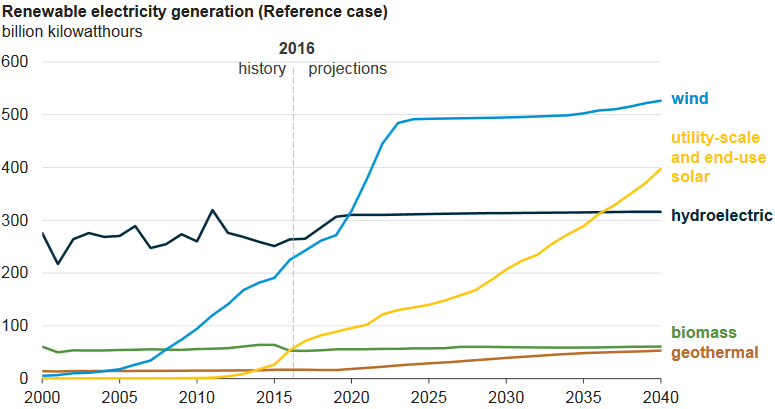News Release from American Clean Power Association (ACP)
Wind Industry Profile of
US DOE expects wind energy to continue growing
There’s good news from the Department of Energy (DOE) today. DOE’s annual report projecting the future of energy in America shows wind power capacity will double from 76 gigawatts (GW) today to 152 GW by the year 2023.
Wind continues to grow
Turbines that can reach stronger, steadier winds mean increased productivity as wind generation will more than double by 2023. That’ll result in wind supplying 12 percent U.S. electricity by that time. The chart below from the Energy Information Administration’s (EIA’s) Annual Energy Outlook illustrates this.
This boost in wind deployment relative to earlier editions of EIA’s outlook is partially driven by EIA updating its assumptions for wind’s cost and better performance to include recent technological improvements.
Because of wind energy’s increased competitiveness, wind deployment is still strong even in EIA’s scenario without federal carbon policy in place, reaching 140 GW by 2023.

Issues in EIA’s analysis
However, new wind deployment drops off significantly in EIA’s scenarios after 2023. This drop-off appears to be driven by an anomaly in EIA’s assumptions about future cost reductions.
EIA continues to incorrectly assume that wind energy’s cost will stop declining and remain roughly at its current levels forever. That’s even though the U.S. wind industry has achieved 66 percent cost declines over the last seven years. Further double-digit cost declines are expected over the coming years.
EIA inexplicably puts wind on the same cost reduction trajectory as century-old fossil fuel technologies, with only five percent cost reductions over the next two decades, while solar and many types of fossil power plants are assumed to reduce their costs by 50 percent or more. As a result, other technologies are able to catch up to and surpass wind’s low cost.
EIA also runs into some confusion regarding current versus future costs when it appears to claim that wind energy may be competitive today without the production tax credit in place.
EIA did not run a scenario without the tax credits in place, so the only basis for EIA’s claim appears to be a comparison of the competitiveness of different energy sources in the year 2022 (page 85). EIA’s estimate shows wind energy to be roughly competitive with natural gas and hydropower in that year.
However, the key problem is that a comparison of cost in 2022 has nothing to do with competitiveness today, which is when investment decisions for wind generation are being made.
Underlying the 2022 cost comparison is EIA’s assumption that natural gas prices will be 80 percent higher in 2020 and 70 percent higher in 2022 than natural gas prices actually were in 2016. However, actual market prices for natural gas futures for the year 2022 are currently trading only 20 percent higher than last year’s prices.
Investment decisions for wind generation being built under the tax credit are being made today based on current gas prices and futures market prices, which are much lower than EIA’s estimate. The only reason EIA uses the year 2022 for its comparison is because other types of power plants take much longer to be built, making 2022 the earliest “least common denominator” year in which EIA can compare all energy sources. Therefore, it is incorrect for EIA to claim that wind energy is competitive today without the tax credit, particularly at today’s very low natural gas prices.
The reality, as various analyses have documented, is that the production tax credit is still essential in the near-term for continuing to drive the deployment, U.S. manufacturing and technological advances that are reducing wind’s costs. That was the sound logic behind Congress’s decision a year ago to phase down the wind production tax credit over five years.
- Source:
- AWEA - Into the Wind Blog
- Link:
- www.aweablog.org/...
- Keywords:
- DOE, AWEA, energy outlook, wind energy, prognosis








